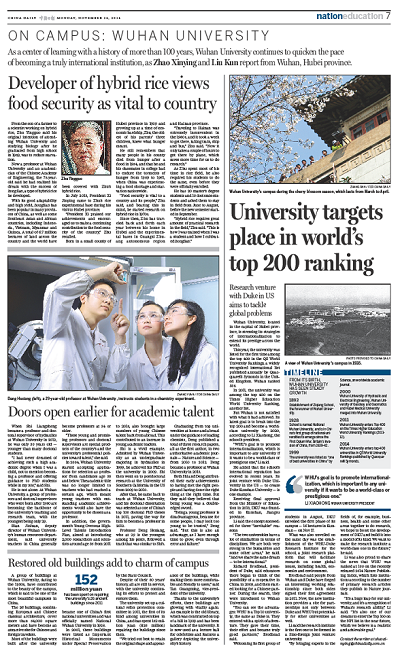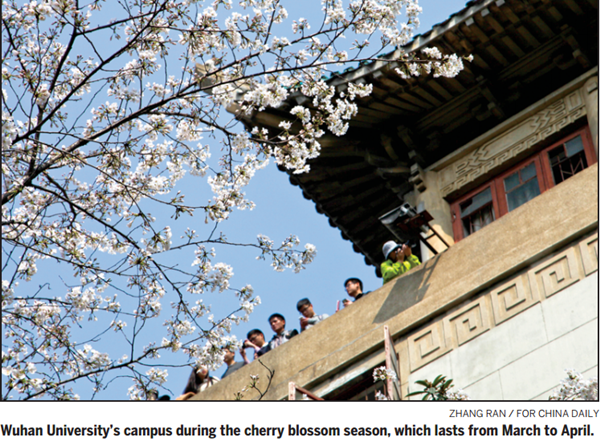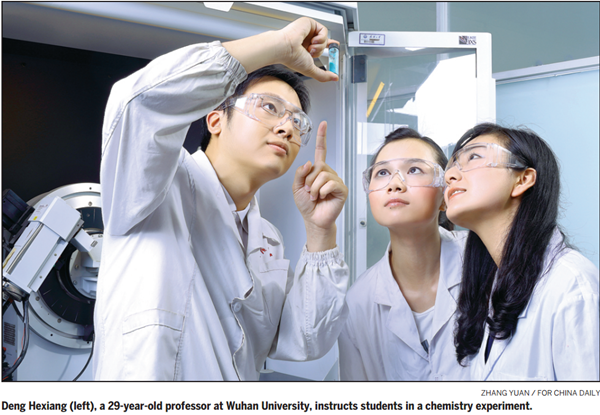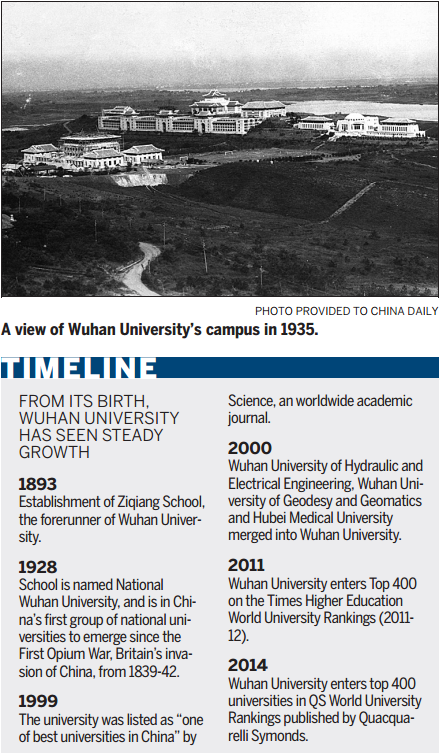编者按:11月24日,我校121周年校庆前夕,China Daily(中国日报)nation education(国家教育版)整版刊发了关于武汉大学的文章,从国际化办学、科学研究、社会服务、人才队伍建设和校园文物建筑保护等方面,对我校进行了全面、深入报道。文章指出:作为一所具有一百多年悠久历史的学府,武汉大学当前着力加强了与美国杜克大学的深入合作,在通往真正高水平国际化大学的道路上提速前进。

As a center of learning with a history of more than 100 years, Wuhan University continues to quicken the pace of becoming a truly international institution, as Zhao Xinying and Liu Kun report from Wuhan, Hubei province.
University targets place in world’s top 200 ranking
Research venture with Duke in US aims to tackle global problem
“WHU’s goal is to promote internationalization, which is important to any university if it wants to be a worldclass or prestigious one.”
LI XIAOHONG WUHAN UNIVERSITY PRESIDENT
Wuhan University, located in the capital of Hubei province, is stressing its strategies of internationalization to extend its prestige across the world.
This year, the university was listed for the first time among the top 400 in the QS World University Rankings, a widely recognized international list published annually by Quacquarelli Symonds in the United Kingdom. Wuhan ranked 335.
In 2011, the university was among the top 400 on the Times Higher Education World University Ranking, another list.
But Wuhan is not satisfied with what it had achieved. Its latest goal is to break into the top 200 and become a world class university by 2020, according to Li Xiaohong, the school’s president.
“WHU’s goal is to promote internationalization, which is important to any university if it wants to be a worldclass or prestigious one,” Li said.
He added that the school’s international reputation has evolved in recent years. Its joint venture with Duke University in the US — to create Duke Kunshan University — is one example.
Receiving final approval from the Ministry of Education in 2013, DKU was founded in Kunshan, Jiangsu province.
Li said the concept succeeded for three “inevitable” reasons:
“The two universities have a lot of similarities in terms of disciplines. We are both very strong in the humanities and some other areas,” he said.“And we share the same dream to be international.”
Richard Brodhead, president of Duke, said educators there began to think of the possibility of a cooperative in China in 2009, and then started looking for a Chinese partner. During the search, they were introduced to Wuhan University.
“You can see the advantages: WHU is a Top 10 university, the same as Duke is. They entered with a spirit of adventure. They gave their time, their effort and became truly good partners,” Brodhead said.
Welcoming its first group of students in August, DKU unveiled the first phase of its campus — 16 hectares in Kunshan — on Nov 17.
What was also unveiled on the same day was the establishment of the WHUDuke Research Institute for the school, a joint research platform that will facilitate research on some global issues, including health, economics and environment.
Brodhead said people from Wuhan and Duke have forged an interesting working relationship since both sides signed their first agreement in 2011. Now, the new institution provides a site for partnerships not only between Duke and WHU but potentially for other universities as well.
Li said the research institute is the first one to be formed in a Sinoforeign joint venture university.
“By bringing experts in the fields of, for example, business, health and some other areas together to do research, we hope to boost the development of DKU and build it into a model of its kind. We want to make the research institute a worldclass one in the future,” he said.
Li was also proud to share the news that WHU was ranked at 105 on the recently released 2014 Nature Publishing Index, which lists institutions according to the number of primary research articles they publish in Nature journals.
“It’s a huge leap for our university, and it’s a recognition of Wuhan’s research ability,” Li said. “It’s also one of our dreams to enter the Top 100 on the NPI list in the near future, which we believe is a realistic and achievable goal.”

Developer of hybrid rice views food security as vital to country
From the son of a farmer to a scientist working on hybrid rice, Zhu Yingguo said his original intention of attending Wuhan University and studying biology after he graduated from high school in 1959, was to reduce starvation.

Now a professor at Wuhan University and an academician of the Chinese Academy of Engineering, the 75year old said he had realized his dream with the success of honglian, a type of hybrid rice he developed.
With its good adaptability and high yield, honglian has been popular in many provinces of China, as well as some Southeast Asian and African countries, including Indonesia, Vietnam, Myanmar and Guinea. A total of 6.7 million hectares of land across the country and the world have been covered with Zhu’s hybrid rice.
In July 2013, President Xi Jinping came to Zhu’s rice experimental base during his visit to Hubei province.
“President Xi praised our achievements and encouraged us to make a continuing contribution to the food security of the country,” Zhu recalled.
Born in a small county of Hubei province in 1939 and growing up at a time of economic hardship, Zhu, the oldest of his parents’ three children, knew what hunger Meant.
He still remembers that many people in his county died from hunger after a flood in 1954, and that he and his classmates in college had to endure the torments of hunger from 1959 to 1961, when China was experiencing a food shortage and starvation nationwide
“Food security is vital to a country and its people,” Zhu said, and bearing this in mind, he started research on hybrid rice in 1970s.
Since then, Zhu has traveled back and forth each year between his home in Hubei and the experimental bases in Guangxi Zhuang autonomous region and Hainan province.
“Traveling to Hainan was extremely inconvenient in the 1980s, and it took a week to get there, taking train, ship and bus,” Zhu said. “Now it only takes a couple of hours to get there by plane, which saves more time for us to do research.”
As Zhu spent most of his time in rice field, he also required his students to do the same, even before they were officially enrolled.
He has 20 master’s degree students and 10 doctorate students and asked them to stay in field from June to August, before the new semester started in September.
“Hybrid rice requires great amount of practical research in the field,”Zhu said. “This is how I was trained when I was a student and how I cultivated honglian.”

Doors open earlier for academic talent
When Shi Liangsheng became a professor and doctoral supervisor of hydraulics at Wuhan University in 2012,he was only 30 years old —younger than many doctoral students.
“I had never dreamed of achieving such a high academic degree when I was a child, not to mention becoming a professor and offering guidance to PhD students while in my 30s,” said Shi.
He is not alone. At Wuhan University, a group of professors and doctoral supervisors who were born after 1980 are becoming the backbone of the university’s teaching and research team, with the youngest being only 29.
Bian Jinluan, deputy director of Wuhan University’s human resources department, said university teachers in China generally become professors at 34 or older.
“These young and promising professors and doctoral supervisors are special products of the country’s and the university’s preferential policies toward talent,” she said.
In 2004, Wuhan University started accepting applications for selection as professor from candidates age 35 and below. The academic title was no longer limited to teachers who had reached a certain age, which meant young teachers with outstanding academic achievements would also have the opportunity to be chosen as a professor.
In addition, the government’s Young Overseas HighLevel Talents Introduction Plan, aimed at introducing 2,000 researchers and scientists around age 35 from 2011 to 2015, also brought large numbers of young Chinese talent back from abroad. This contributed to an increase in young academic leaders.
Shi is a vivid example.Admitted by Wuhan University as an undergraduate majoring in hydraulics in 1999, he achieved his PhD at the university in 2009. Shi then went on to postdoctoral research at the University of Southern California in the US from 2009 to 2010.
After that, he came back to teach at Wuhan University, and his doctoral dissertation was selected as one of China’s top 100 doctoral PhD theses in 2011, paving the way for him to become a professor in 2012.
Professor Deng Hexiang, who at 29 is the youngest among his peers, followed a track that was similar to Shi’s. Graduating from top universities at home and abroad under the guidance of leading chemists, Deng published a total of three research papers, all as the first author, in two authoritative academic journals — Nature and Science — from 2010 to 2012. Deng became a professor at Wuhan University in 2013.
Both Shi and Deng attributed their early achievements to having met the right people and having done the right thing at the right time. But they said they believed that being young was a doubleedged sword.
“Being a young professor is disadvantageous, because for some people, I may look too young to be trusted,” Deng said. “But this is also an advantage, as I have enough time to grow, even through error and failure.”

Restored old buildings add to charm of campus
A group of buildings at Wuhan University, dating to the 1930s, have contributed to the beauty of the campus, which is said to be one of the most beautiful campuses in China.
The 26 buildings, combining European and Chinese classical architecture, cover more than 54,000 square meters and have become an attractive site for Chinese and foreign travelers.
Most of the buildings were built after the university became one of China’s first national universities and was officially named National Wuhan University in 1928.
In 2001, these buildings were listed as Important Historical Monuments under Special Preservation by the State Council.
Despite of their 80 years’ history, all are still in service, with the university continuing its efforts to protect and restore them.
The university set up a cultural relics protection committee in 2011, the first of its kind among universities in China, and has spent 152 million yuan ($25 million)repairing the buildings since then.
“We tried out best to retain the original shape and appearance of the buildings, while making them more comfortable and friendly to users,” said Tan Guangming, vicepresident of the university.
Thanks to the university’s efforts, these buildings are glowing with vitality again. An example is the old library, which was constructed on top of a hill in 1939 and has been landmark of the university. It is now used as a lecture hall for celebrities and features a gallery depicting the university’s history.
http://www.chinadaily.com.cn/cndy/2014-11/24/content_18963785.htm
(稿件来源:China Daily 2014年11月24日 本网编辑:吴江龙)